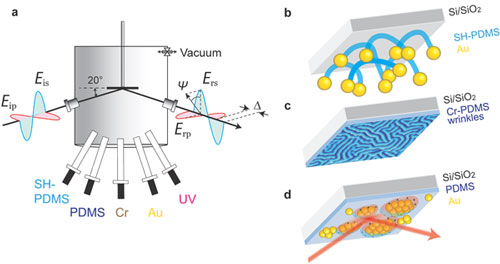| Posted: Jun 13, 2017 |
Active implants: How gold binds to silicone rubber
(Nanowerk News) Ultra-thin and compliant electrodes are essential for flexible electronic parts. When it comes to medical implants, the challenge lays in the selection of the materials, which have to be biocompatible. Silicones were particularly promising for application in the human body because they resemble the surrounding human tissue in elasticity and resilience. Gold also poses an excellent electrical conductivity but does only weakly bind to silicone, which results in unstable structures.
|
Molecular conductive glue
|
|
An interdisciplinary research team of the Biomaterials Science Center and the Department of Chemistry at the University of Basel has developed a procedure that allows binding single gold atoms to the ends of polymer chains (Advanced Electronic Materials, "Time-resolved plasmonics used to on-line monitor metal-elastomer deposition for low-voltage dielectric elastomer transducers").
|
|
This procedure makes it possible to form stable and homogeneous two-dimensional gold films on silicone membranes. Thus, for the first time, ultra-thin conductive layers on silicone rubber can be built.
|
 |
| Thin film preparation scheme. a) Cross section of the organic molecular beam deposition setup for the fabrication of soft multi-layer nanostructures under ultra-high vacuum conditions. In situ spectroscopic ellipsometry at an incident angle of 20° simultaneously monitors film thickness, optical properties, and plasmonics. Representative schemes of thermally grown soft nanostructures: b) self-assembled Au particles bound to bi-functional, thiol-terminated PDMS; c) wrinkled Cr/PDMS; d) Au nanoparticles on a PDMS membrane. Coherent electron oscillations occur if the nanoparticles become excited at the resonance frequency. Due to the incident 4 × 10 mm2 beam dimension, SE monitors nanostructures over a macroscopic area. (© Wiley-VCH Verlag)
|
|
The novel approach: Firstly, the thermal evaporation of organic molecules and gold atoms under high-vacuum conditions permits preparing ultra-thin layers. Secondly, their formation from individual islands to a confluent film can be monitored with atomic precision by means of ellipsometry. Using masks, the sandwich structures fabricated can convert electrical energy into mechanical work similar to human muscles.
|
Energized silicone rubber
|
|
These dielectric artificial muscles could simultaneously serve as pressure sensors and may, in the future even be used to harvest electrical energy from body movement. For this purpose, the silicone membranes are sandwiched between electrodes. The relatively soft silicone then deforms according to the applied voltage.
|
|
So far, the silicone membranes were several micrometres thick and required high voltages to reach the desired strain. These new nanometer-thin silicone membranes with ultra-thin gold electrodes allow operation through conventional batteries. To bring such a product to the market, the production costs would have to be reduced drastically.
|
|
However, Dr. Tino Töpper, first author of the study, is optimistic: "The perfect experimental control during the fabrication process of the nanometer-thin sandwich structures is a sound basis for long-term stability – a key prerequisite for medical applications".
|

